#cordgrass
Explore tagged Tumblr posts
Text
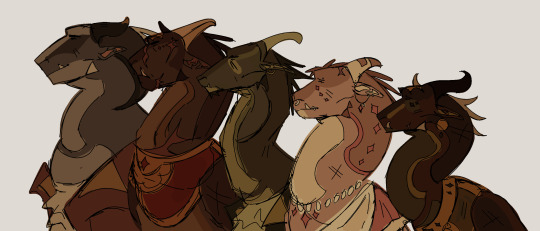
the mudwing delegation
from left to right - badger, prince hoatzin, cordgrass, kaolin, princess caiman
#once again begging you guys to PLEASE🙏🙏🙏 check out my wof fanfic#wof#wings of fire#wof oc#wof ocs#wings of fire oc#mudwing#badger wof#hoatzin wof#cordgrass wof#kaolin wof#caiman wof#terror of talons#rave art#wof art
439 notes
·
View notes
Text
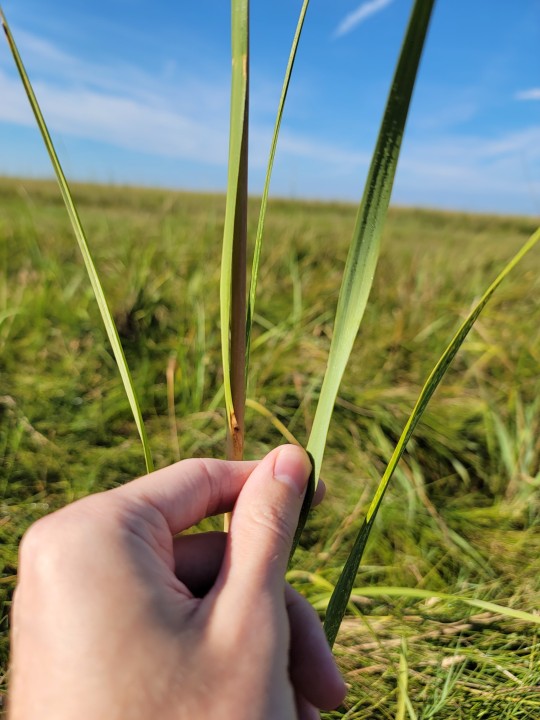
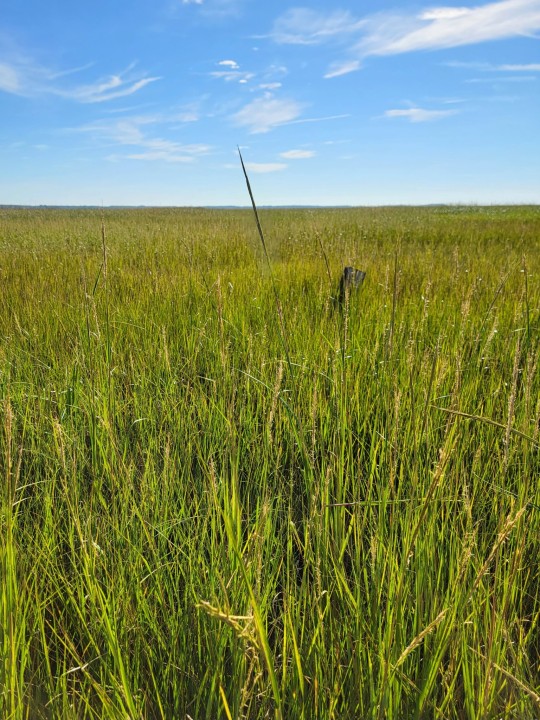
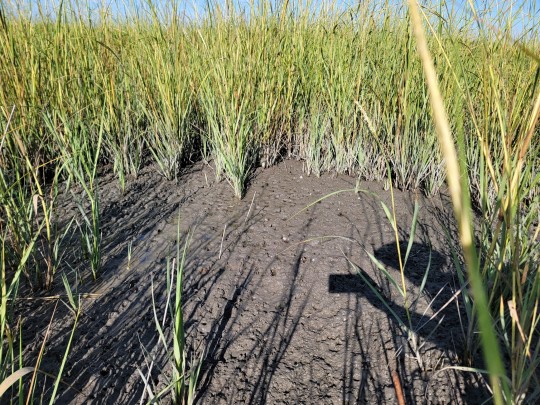
Spartina Alterniflora (aka Sporobolus Alterniflorus) - Smooth Cordgrass
Smooth Cordgrass is many things: a signifier of salinity, an extremophile, a creator of habitat, and a peat builder. This lovely species typically colonizes the low marshes of heavily salinited areas near the ocean where other plants cannot. It is endemic to the Atlantic coast of both North and South America, forming the backbone of most brackish ecosystems. While it may appear to create a monoculture within its habitat niche, Cordgrass actually does such an important job in building marsh.
As sediments collect from rising tides the colonal roots of this plant trap nutrients to accure peat and in turn provides a lot of habitat for mussels, fiddlercrabs, nesting birds, and other prey species. The process of building this peat is called marsh accretion, its what allows marshes to build elevation and migrate in the face of sea level rise. Similar to Mangroves, Cordgrass can monopolize saline habitats due to its ability to survive tidal conditions and secret salt from its leaves (zoom in on the leaf with my finger to see salt crystals collecting).
Salt grass can grow up to six feet tall and typically spreads colonally or via seed. As sea levels rise many existing salt marshes are dying, however, cordgrass individually is rather resilient, as it is one of the few species which can cope under increasing exposure to salinity. In Philadelphia we see this species slowly creep up the waterways as salinity increases up the Delaware River. Spartina Alterniflora is very famously invasive in other areas of the world however here where there is biological control we see heavy losses to existing ecosystems (especially in the Chesapeake bay) as stresses from climate catastrophe increase.
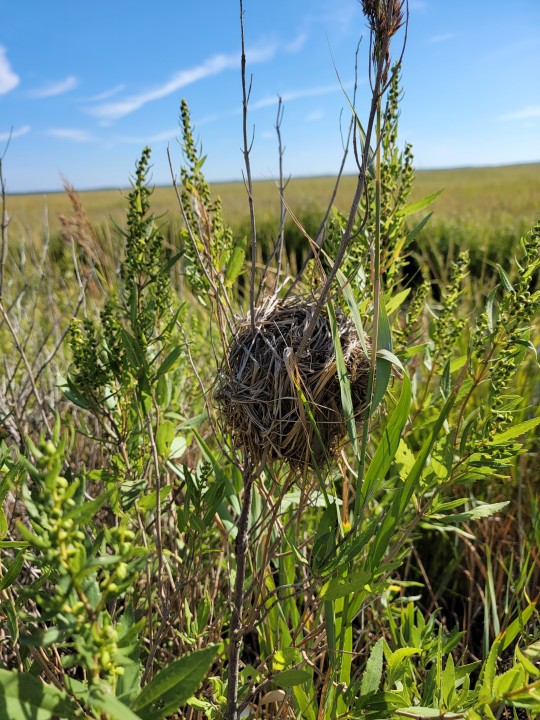
I have a lot of love for this species and it's ability to carve out a bountiful ecosystem in what is considered a desert to almost all other lifeforms (image above: Nest made from cordgrass).
#native plants#brackish ecosystem#Delaware bay#spartina alterniflora#smooth cordgrass#salt marsh#brackish ecosystems of the american atlantic#i believe spartina is an extremely distinct genus which is why i don't use sporobus personally#but that's a very Mid-Atlantic opinion apparently#which the science is still debating a bit on#plant profiles
5 notes
·
View notes
Text


#new york landscape#eastchester bay#saltmarsh cordgrass#sporobolus alterniflorus#aquatic plants#algae#beach#marsh#pelham bay park#bronx
0 notes
Note
Wait, which animals raise livestock?
Several species of ants will 'herd' aphids around (a type of plant lice)- even picking them up and putting them back with the group if they wander off. The ants will attack anything that approaches their aphid herds, defending them. The aphids produce a sugary excretion called honeydew, which the ants harvest and eat.
Some ants will even 'milk' the aphids, stroking the aphids with their antennae, to stimulate them to release honeydew. Some aphids have become 'domesticated' by the ants, and depend entirely on their caretaker ants to milk them.
When the host plant is depleted of resources and dies, the ants will pick up their herd of aphids and carry them to a new plant to feed on - a new 'pasture' if you will.
Some ants continue to care for aphids overwinter, when otherwise they'd die. The ants carry aphid eggs into their own nests, and will even go out of their way to destroy the eggs of aphid-predators, like ladybugs.
--
Microhylids – or narrow-mouthed frogs - have an interesting symbiosis with Tarantulas.
While the spiders could very easily kill and eat the much-tinier frogs, and DO normally prey on small frogs, young spiders instead will use their mouthparts to pick up the microhylid frogs, bring them back to their burrow, and release them unharmed.
The frog benefits from hanging out in/around the burrow of the tarantula, because the tarantula can scare away or eat predators that normally prey on tiny frogs, like snakes, geckos, and mantids. The tarantula gets a babysitter.
Microhylid frogs specialize in eating ants, and ants are one of the major predators of spider eggs. By eating ants, the frogs protect the spider's eggs. The frogs can also lay their eggs in the burrow, and won't be eaten by the spider.
So it's less 'livestock' and more like a housepet - a dog or a cat. You stop coyotes/eagles from hurting your little dog/cat, and in return the dog/cat keeps rats away from your baby.
--
Damselfish grow algae on rocks and corals. They defend these gardens ferociously, and will attack anything that comes too close - even humans. They spend much of their time weeding the gardens, removing unwanted algaes that might overtake their crop.
The species of algae that they cultivate is weak and and sensitive to growing conditions, and can easily be overgrazed by other herbivores. That particular algae tends to grow poorly in areas where damselfish aren't around to protect and farm it.
Damselfish will ALSO actively protect Mysidium integrum (little shrimp-like crustacians) in their reef farms, despite eating other similarly sized invertebrates. The mysids are filter feeders, who feed on zooplankton and free-floating algae, and their waste fertilizes the algae farms. Many types of zooplankton can feed on the algae crop, and the mysids prevent that.
While Mysids can be found around the world, the only place you'll find swarms of Musidium integrum is on the algae farms that Damselfish cultivate.
Damselfish treat the little mysids like some homesteaders treat ducks. Ducks eat snails and other insect pests on our crops, and their poop fertilizes the land. The ducks can be eaten, but aren't often, since they're more useful for their services than their meat.
--
There are SEVERAL species of insect and animal which actively farm. They perform fungiculture and horticulture: deliberately growing and harvesting fungus and plants at a large-scale to feed their population.
Leaf-cutter ants and Termites both chew up plant material and then seed it with a specific type of fungus. The fungus grows, and the termites/ants harvest the mushroom as a food source.
Ambrosia beetles burrow into decaying trees, hollow out little farming rooms, and introduce a specific fungii (the ambrosia fungi), which both adults and larval beetles feed on.
Marsh Periwinkles (a type of snail) cultivates fungus on cordgrass. They wound the plant with their scraping tongue, then defecate into the wound so their preferred fungus will infect it and grow there. They let the fungus grow in the wound a bit, and come back later to eat.
8K notes
·
View notes
Note
Hi. My wife referred me to you for your knowledge and enthusiasm for ecology. If I wanted my fictional fantasy world to have a saltwater river (my world is weird), how could I explain or justify that? Is it even possible, ecologically speaking? Anyway, love your posts and thank you!
I have been considering this with my colleague who is a physical geographer with a passion for riverine geomorphology and she wants to sit down with me and discuss the possibilities more fully. So I may yet update this post with more options.
But, the short answer is yes, there are options to make it possible.
The one we've best fleshed out so far basically comes down to groundwater contamination. Groundwater is contaminated with massive salt input (this would likely need to be anthropogenic - up to you whether that looks like Evil Factory Output, massive magical damage post-war, or any other consideration.) One or more of the river's main tributaries is fed primarily by this groundwater store, so it cannot flush through. Once it meets the sea, it would be brackish around the estuary anyway, but this would mean halophilic species - those tolerant of salt - would be able to spread backwards back up the river channel. Depending on what you want, for plants this could mean cordgrasses (saltmarsh formers), seagrasses along the riverbed in slower areas, or potentially long, linear stands of mangrove forest; in all of those cases, it's much more likely on a slower river than a faster one.
Now, a salt river will be far more erosional than a fresh one, so the river banks and bed would be eroding more. This means higher quantities of suspended sediment in the water, so the water colour would be murkier and browner than if it were fresh. However, if its a river with slow meanders, you might get little patches of saltmarshes establishing, where the erosion turns into deposition instead, so although the water would have a colour difference it would be extreme; on faster bits, though, it would.
There would be, either from the groundwater at the top of the catchment or along the river channel, a certain amount of salt incursion into land. This would basically make arable agriculture in those areas nigh-on impossible, but you could maybe try farming something like samphire along the banks. The exception would be areas that were away from the contaminated aquifer, that also got plenty of rainfall OR freshwater groundwater imputs from another part of the catchment. Even then, though, it couldn't go too close to the river.
Floodplains need considering, too! Floodplains only flood during wet weather events that cause the river to overtop the banks; the rest of the year, they're dry. In this case, that means you might have areas that are freshwater marshes, or maybe even normal grasslands/scrub for most of the year, which then suddenly get inundated with salt. That'll kill all those organisms quite rapidly. You wouldn't have any trees in those areas, and they'd look like mudbaths for the majority of the time, I'd imagine. Very ugly wastelands. These would then provide even more lost soil into the river, for even more browning of the water.
That much sediment would therefore mean the estuary would be a depositional one - new land forms at it. It would probably have a delta. This means lots of mudflats with lots of marine worms and other invertebrates, and consequently insane levels of wading bird diversity to feed on them (plus foodstuffs - oysters, cockles, octopus, smaller fishes, etc). Loot up Korean getbol for an idea of how impressive these things can get. Saltmarshes and/or mangrove forests, too! Depending on climate. Mangroves are a tropical species.
HOWEVER, this is just one idea we've explored so far, so I shall update you if we think of others
456 notes
·
View notes
Text

Here's my (probably only, sadly) post for Solarpunk Aesthetic Week! Originally made for Andrewism's 2023 Solarpunk Art Collab!
This digital painting depicts the Southern Great Lakes Ecoregion, within the Interior Plateau & Southern Great Lakes Forests Bioregion, within the Temperate Broadleaf and Mixed Forest Biome.
I chose a suburban setting for this piece because I've not yet seen a Solarpunk artwork that features this. I'm aware of the problems with the suburbs, but it seems to me more sustainable to try to adapt them than to demolish them and start over. So instead of lawns I've depicted beds of native Indiana plants, including but not limited to:
Amsonia Tabernaemontana (Eastern Bluestar)
Spartina Pectinata (Prairie Cordgrass)
Echinacea Purpurea (Purple Coneflower.
The roofs of the houses are either white to help reflect heat, or green roofs. Some of the houses are equipped with solar panels on the south sides, and one is shown with a greenhouse on that side as well.
While perhaps not explicitly ecologically focused, I have shown there to be more art in this setting than is usually found in american suburbia. The sidewalk has a mural painted with hydrochromic paint, which only appears while it is raining. The houses are painted bright colors (white or greige is considered 'Normal' ) and are occasionally decorated with murals.
This particular area is among the cloudiest in the so-called U.S.A. To reflect that, the weather is overcast and it is currently raining.
Hope y'all enjoy this, and Happy Solarpunk Aesthetic Week!
793 notes
·
View notes
Text
When I first came to Ajax, when I stepped out of the red-and-yellow shuttle to plant my feet in the planet's sand, what I noticed before anything else was how pale the buildings are. On Mars, even in the warmest and most equatorial provinces, human habitation is universally black (or its best approximation), built from fulcrete and basalt and painted wood, to absorb the warmth of the sun against the bitter cold. On Ajax, far closer to its sun than Mars or even Earth, and with its 39-hour days, they must build for the opposite, towers of white or reflective silver with burrowed basements and sub-basements and sub-sub-basements underneath. The Ajactes live in cities the color of bone. The second thing I noticed, the thing that probably any other person would notice first, was the surfeit of salt in the air. I noticed this because it stung my eyes, like the threat of tears. As it happens, Ajax's oceans are significantly more saline than Earth's or Emieni's, and even its topsoil is a kind of hardpan composed of sand and dust cemented in a salt matrix. For the first several centuries of its habitiforming, it hosted an extremely carefully managed tight ecosystem of halophilic algae, bacteria and lichen painstakingly shipped from Earth and Mars, fed upon by a few species of brine shrimp. Gradually, the Hesperides introduced more species as the previous ones found their foothold: turtleweed and saltbush and cordgrasses, periwinkles and blue crabs and flamingos, suites of genetically-modified mangroves whose knees whistled in the morning and evening hours, bananas and maize and halotolerant rice. Most recently (within the last two hundred and fifty years) the Ajax Planetary Authority had grown increasingly bold and experimental: a breed of sheep brought out of cryogenic vaults on Old Earth to eat the masses of seaweed that washed ashore around the Southernmost Continent, whitetail deer both to manage the turtleweed scrubland that was covering the northern half of the Great Continent and to provide a stable meat source more robust than flamingos and periwinkles, a kind of gopher tortoise/diamondback terrapin hybrid that had proved encouragingly robust in the prairies of Mars, and even tigers to laze about in the shade of the forests that bordered saltmeadows full of bounding deer. All the Ajactes I spoke to seemed both personally invested in and extraordinarily proud of these tigers, showing me images and videos on their utility wedges, and several of the state television channels would cut away to live feeds of the animals sleeping or bathing their cubs or stalking prey.
62 notes
·
View notes
Text



I was taking a walk
And I took these pictures of some gulls ,cordgrass , Phragmites, and the Hackensack river 
#mudflats#native plants#meadowlands#seagulls#hackensack river#phragmites#new jeresy#Secaucus#marsh#nature#urban birding
3 notes
·
View notes
Text
October 10th, 2023


Ragworm (Hediste diversicolor)
Phylum: Annelids
Distribution: Native to the north-east Atlantic, from the Baltic and North seas to the Azores and Mediterranean seas. Also found in regions of the north-west Atlantic, such as the gulfs of Maine and St Lawrence, and Cobscook bay.
Habitat: Benthic; sand or mud of beaches and estuaries in intertidal zones, including areas of low salinity.
Diet: Varied and adaptable. Predator and general scavenger; feeds mainly on phytoplankton, zooplankton, diatoms and bacteria, as well as detritus, feces and aquatic plants.
Description: Ragworms are polychate worms in the Nereidae family. At maturity, they can reach up to 10 centimetres in length (4 inches) with up to 120 segments. they swim along the sea floor using the bristly parapodia found on either side of each segment.
Ragworms create U-shaped burrows in soft substrates, then creates a water current in order to draw in particles, which are trapped in a mucus net it sets at the entrance of the burrow. If there are no available particles to trap, ragworms will emerge from their homes and hunt for small invertebrates. They're also one of the few animals known to garden; they will draw cordgrass seeds into their burrows and allow them to sprout in order to produce their own food.
The name diversicolor stems from the fact that, as the breeding season approaches, the ragworm's color will shift from brown to green; males, usually indistinguishable from females, turn a bright green, while the females' dorsal surface takes on a dull green coloration. During the mating season, the male will approach a female's burrow and release pheromones, then will release sperm at the entrance of the female's burrow. She will then draw in the sperm using a water current. After spawning, both the male and female die.
The ragworm is a model laboratory animal for research, as well as to evaluate sediment quality. It is also commonly used as bait for sea fishing.
(first picture and video by me, second by Eric A. Lazo-Wasem)
Video of a ragworm swimming under the microscope under the cut!
24 notes
·
View notes
Text
༝ ˚ 。⋆𝐎𝐍𝐄⋆。 ˚ ༝
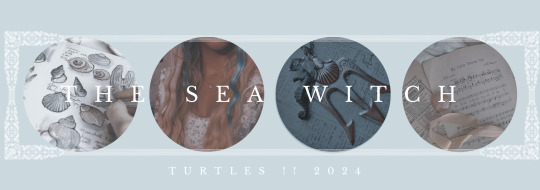
The Sea isn't like most people.
No, the sea isn't like people at all. She is calm when allowed and wild when provoked.
The sea is not just. The sea is wild, natural. She is a part of nature, the most vital part of nature.
The sea is life. The ocean makes up over half of the planet and is vastly undiscovered.
Who are we without the sea? What is earth without the ocean? We are the blue planet after all, a people with bodies made up mostly of water. The sea flows through us.
"Mother Ocean" as she is so famously called, is as vital to us as the air we breathe. Water is the key to life.
Essential.
We must have it to live but we cannot control it. Not even magic can tame it. The ocean doesn't listen to us and we have chosen to ignore it more and more.
But one day, the ocean did listen to us. The ocean did act as a person and the results were far beyond what anyone could comprehend. Certainly no muggle, no ordinary city dwelling person could ever understand it.
My name is Sereia, I am the one that the sea spoke for. Because of its intervention in my life I became the one and only Sea Witch.
𓆝 𓆟 𓆞
Unlike most people who were raised by their human mommas and pappas, wizard or muggle alike, I was raised by the sea.
I know what you're thinking, I don't need magic for that. How is that possible?
Stop asking questions. Stop doubting me. Just hush up and listen, would you? That's why you're here, ain't it? And don't go telling me that "ain't" isn't a word. I don't care. I was raised by the sea, remember? You really think I'm gonna speak correctly? Nope. get some perspective here, little girl raised by the sea in the wild on one of them remote costal islands. I'm going to do anything but speak correctly.
I've never minded living out here on my own. Some people will claim that the carolina crystal coast is one of the most beautiful things they have ever seen. They'll swear it up and down. And they're absolutely right.
And just how did I get to living out here all alone with no momma or poppa? Well, that's the thing, ain't it? I don't really know. I had parents, once, we all do. But what happened to them I just can't say.
I remember their faces, distant and blurry. I remember being young and loved and laughing as I ran up and down a sand bank, playing with them.
I remember sudden cries of panic and shouts for me to be spared. Then a flash of green light and someone shielding me from whatever took them. Ever since then it was just me and the ocean.
𓆝 𓆟 𓆞
Now you're probably all wondering how such a wild thing as me, ended up in hogwarts.
Go on, you can ask me, I won't bite. You'd say "How did you end up at Hogwarts, Sereia?"
There you go. Well, it all started on a hot summer day. I had been working, doing what I had always done since the loss of my parents. I needed something to distract myself and the only reliable thing in my life now had been the sea.
And thus, I began to study it. I would wake up, eat, go outside to the marsh and find some snails curling up the cordgrass. I'd be in the water with them, of course, no use in trying to study something if you ain't gonna be in the water with it.
I'd sketch a picture of it, write down what I had observed it doing, and then lunch. Then after lunch it was back to studying something.
This time I would take to the shells on the shore. I'd sit out there in whatever dress I had decided to ruin that day, my belly against the sand, and draw whatever shell I had chosen as my subject. I would write down some key aspects of it and how many like it I could find, and then it was back home for supper and bed.
But if it were summer, or at least somewhat warmer out, I'd go out side to watch the fireflies. They were like summer stars, watching them fly about and shine their lights. I studied them too. Fascinating creatures, fire flies, did you know the females are cannibals?
Sure are, they eat the males when they're feeling hungry and don't have to mate. In all my time, studying those fascinating creatures, I never sought to study the most fascinating creature of all. Myself.
𓆝 𓆟 𓆞
It wasn't until that summer's day that I woke up to an Owl on the perch of my open window, with a letter in its beak that I realized something was up.
Where I come from, we have owls. They're a normal thing. But they don't come out during the day and they ain't decadent snowy white owls.
Which was exactly what this one was. So, naturally, I spent about five minutes just staring at the impossible thing in my window then actually doing something about it.
When I finally processed that there was an actual owl in my window and not just some sort of hallucination, I retrieved the envelope from its beak.
Once I did it flew off. Inside it there were two letters. The first, an acceptance letter to some school I had never heard of. Hogwarts. But the other was the more interesting of the two. It read as follows:
Sereia,
I can't believe I have finally found you.
It fills my heart with joy to know that you are alive and well. I send this to you in great enthusiasm and urgency.
Ever since your parents deaths I have worried about you. I have been trying for years to not only locate you, but to convince professor Black, the headmaster here at Hogwarts, to allow us to take you in and give you a safe home for you to own your skill as a young witch.
I have finally gotten through to him. He has allowed for you to come and start late as a six year. You will be assigned into the house which I am the head of, and your father was in, Slytherin.
Do not worry about any supplies. I will take care of it for you and you will find that it will all be delivered to your new dorm room.
I am ecstatic to meet you. I heard of you often via your parent's letters when you were young. They talked fondly of you, their little sea witch. They had always hoped that you would come here to hone your skill one day.
It is time to fulfill their wishes, Sereia. I will see you soon.
Best wishes,
Marina River
And really that was how this was all set into motion. I was taken to Hogwarts, it was the first time that I had seen a person who was not myself in a long while.
It was a lot to take in, no, that was an understatement, it was too much to take in.
This woman, Marina, had sent me another letter just days before my arrival at Hogwarts and had told me that she would meet me in the "Central Hall".
I had no idea what that was or where it was. I would just have to find my way there, at least that's what I thought. I never expected to meet the most unlikely guide on my first day.
Have you ever heard of "The blind leading the blind"? I'm assuming that you're getting what I'm saying. But yeah, I got so lost and turned around that the blind kid had to show me how to get to where I was supposed to go.
This is how I made my first "Friend". This is how I met Ominis Gaunt, the heir of Slytherin.

Masterlist
Table of Contents
Next Chapter ➵
#fanfiction#ao3 writer#fanfic#fanfic writing#fanfics#hogwarts#hogwarts legacy#hogwarts legacy ominis#hogwarts legacy sebastian sallow#sebastian sallow fanfiction#sebastian sallow x oc#sirencore#siren#siren oc#hogwarts legacy sebastian#hogwarts legacy game#hogwarts legacy fanfic#wattpad#wattpad writer#wattpad fanfic#harry potter#slytherin#slytherin house
4 notes
·
View notes
Note
please tell me more about your favorite estuary creatures and features 🥺 (<- is largely unfamiliar with this ecosystem) also happy sleepover saturday and many congratulations on graduating 🩷🎉🫂
oo well i think every estuary is different BUT around here we get big patches of cordgrass that essentially form little islands in the bays and salt marshes, under the water line huge colonies of mussels grow in the roots which both help to anchor the grasses and prevent erosion as well as filter the water of pollutants. above the water line a lot shorebirds will nest in the grasses during the summer, especially gulls, and when you're kayaking around you can see them sitting on their nests peeking out of the grass. when the tide is low the sand banks and mud flats are exposed and you'll find a lot of oystercatchers, pipers, and plovers running around and digging for food in the muck. herons and egrets are common too wading around the edges of mud flats and cordgrass islands, and cormorants in the water or on perches. we also have man made raised platforms set up by the state to support osprey populations, and they're really common to see both nesting and flying around hunting. occasionally i'll spy some brown pelicans hanging out on decaying docks or (depending on the location) bald eagle nests in the trees.
underwater we get a lot of blue crabs (shoutout mid atlantic) and horseshoe crabs (largest population in the world!). i luuuv the horseshoe crabs they are such fascinating critters, and completely harmless even though they look kinda freaky and pointy underneath. i've seen fiddler crabs in the mid flats too, and occasionally a sea cucumber or sea snail in the water. sometimes jellyfish; small wispy white ones (idk the species), i don't think they're very harmful but i wouldn't go sticking my feet in the water if they're around either. and my favorite diamondback terrapins, these adorable little turtles with spotted faces that live in and around the estuaries here. i love kayaking around cause you'll just see their little heads poke up out of the water and then disappear a moment later in front of your boat
#sasha answers#kingfisherkink#tyyy#can you tell my whole family is into birds and nature....lol#i spent every summer coming to the shore for a week or two growing up and kayaking the bay remains one of mym favorite activities#I FORGOT TO SAY WHAT AN ESTUARY IS.#basically it's a body of water between an ocean and a river#so there's a mix of salt and freshwater characteristics
8 notes
·
View notes
Text
The Conservationist’s New Best Friend
Raasay, a young border collie, leans over the edge of a kayak, to catch a whiff. It’s not a ball she’s sniffing out. Rather, she’s hunting down a potential ecological threat hidden beneath the surface. Her target during this training session: an invasive aquatic plant, known as common cordgrass (Spartina anglica), that has found its way into many Australian lakes, mud flats, mangrove forests,…
0 notes
Text

"Mmhm."
He would not tease so vehemently, too busy with taking in how Vox wore the sweater he'd lent and finding it to be not quite the style he'd known the other man for. But no less interesting. Adorable? Appealing? Something in that vein that he did not feel like honing in on a specific word for.
"Come on then, adventurer," Alastor said with a smirk, drifting towards the faux-moonlit bayou with ease and allowing Vox to follow either behind or alongside. Whichever he had a preference for. Not so bold to offer his hand or anything yet - but he did not think the other minded so much. They'd already spent quite a bit of time in the immediate vicinity of one another in the bath. Which seemed a much more intimate venue.
Stepping from the wood floor and into the soft, smooth cordgrass that formed little islands between watery, slightly muddy pools which extended well beyond the sight-line. As he'd seen earlier, the bayou was much larger than made sense for the size of a typical hotel room - and it was easy to get lost. But with Alastor's red hair and attire, he could act as a relative beacon, taking Vox past the willows in the immediate vicinity of the room and into the swampland proper.
As they left the sight of his actual room, the sounds of the 'animals' that thrived within the bayou took over the general atmosphere. Non-existent crickets, frogs, cicadas, and a few birds here or there gave the illusion of life - life that he was not truly able to create, but could mimic well enough, he supposed. There was a casual glow of fireflies that emanated around them, and the slight rustle of the willow trees from a breeze that was not really there. Could not really be felt on the face.
But it was somewhat humid - and a steady fog rolled in and out around them. But not so much as it had done before.
"I take it you did not spend much time out in nature," he said after a few minutes of walking, his gaze fixed on a small shadow-frog that hopped from a nearby lily pad and into the water.
Vox had put the broken snake out of his mind upon seeing Alastor. He looked so... Casual. Domestic even. That was a scary word. He would put that one out of his head.
The TV head had to stretch the neckline of the dark blue sweater he was given. The seams crackled and snapped a few places, but he was otherwise able to pull it over his head easily enough. The stretching just meant that it sagged forward in his chest, very narrowly missing the mark to hanging low enough to show his nipple.
He never wore things like this. Loose ontop casual..
"I don't need a warning.. I was functionally blind before- and you snuck up on me." He defended pitifully.
Vox started out of the bathroom and into the main room again. Absorbing it's decor properly now that he could see it. Then back to Alastor to appreciate the fit once more. It really did make his waist look very nice.
The black pants that were provided were a tiny bit too long, but he just hiked them up and then they worked perfectly.

207 notes
·
View notes
Text
@tretramonti
continued from here
Eric had learned the hard way not to rock the boat. They had come out here in his boat many a time, and many a time, what began as lying in each other’s arms staring up at the stars shifted into far more vigorous activities—and many a time, the boat tipped over. So this time, he had thought ahead.
And he was glad he had. Though the water had never deterred either of them, here in the cordgrass, they were uninterrupted. His hands were secure at either side of her hips as he moved within her steadily, needing more just as much as she did, but enjoying the sound of her voice. He told her as much, and as her legs tightened around him, he groaned, burying his face in her neck.
When she bit him, the clarity evaporated, and his hips moved faster, greedily, his lips shifting to her collarbone as he slid his hand between them, rubbing her clit.
1 note
·
View note
Text
Global Weed Control Market Is Estimated To Witness High Growth Owing To Increasing Global Food Demand

Weed control is the management and suppression of unwanted plants, commonly referred to as weeds that grow in areas where they are not desired. Weeds are plants that compete with cultivated crops, native vegetation, or landscaping plants for resources like water, nutrients, and sunlight. They can significantly impact agricultural productivity, natural ecosystems, and the aesthetic value of landscapes. There are various methods of weed control, ranging from chemical herbicides to cultural and mechanical practices. Chemical herbicides are substances designed to kill or inhibit weed growth selectively, without harming desired plants. They are commonly used in agriculture, forestry, and urban settings. However, the use of herbicides requires careful application to minimize environmental impact and health risks. Cultural practices for weed control include crop rotation, mulching, and maintaining proper planting density to reduce weed competition. Mechanical methods involve physically removing weeds through hand-pulling, hoeing, or using specialized tools like weed trimmers and mowers.
Market Dynamics:
Rising product launches are estimated to augment growth of the globalweed control market during the forecast period. For instance, Habitat Aqua herbicide was launched by BASF SE, in June 2021. The product has been approved for use in and around aquatic sites as it offers effective control over invasive species like flowering rush, phragmites, knotweeds, and cordgrasses. Moreover, rising toxicity associated herbicides and increasing strict regulations areanticipated to restrain growth of the globalweed control marketduring the forecast period.
Impact of COVID-19:
The pandemic had an adverse impact on many countries. This outbreak was transmitted to more than 100 nations. COVID-19 impacted various manufacturing industries, and it also hampered the global economy. Several industries were shut down, and strict restriction caused disruptions of supply chains. These restrictions imposed in several countries led to lack of raw materials and there was a shortage of manpower in many industries. Manufacturing activities were halted in many parts of the world. This had a significant impact on weed control market. The pandemic restrained growth of the globalweed control market. However, in the post-pandemic era, as all restrictions have now been eased the market is estimated to witness growth.
Key Takeaways:
The globalWeed Control Market is expected to witness high growth, exhibiting CAGR of 5.8 % over the forecast period, due to growing investments. For instance, a UK-based agricultural biotech startup Moa Technology secured USD 44 million in funding in 2022. The company is aiming to discover innovative and sustainable alternatives for overcoming the challenges related to herbicide resistance.
North America is anticipated to witness significant growth in the globalweed control market during the forecast period, due to increasing commercial farming operations and growing agricultural sector.
Key players operating in the globalweed control market are Valent Biosciences Corporation, BASF SE, Syngenta AG, Adama Agricultural Solutions Ltd., Rotam Crop Sciences Ltd., Bayer crop science AG, Nufarm Limited, Dow chemical company, Nissan Chemical Industries LTD, Drexel Chemical Company, Monsanto Company, Dupont Company, and FMC Corporation.
0 notes
Text
China battles alien marsh grass at unprecedented scale | Science#China #battles #alien #marsh #grass #unprecedented #scale #Science
Along its 18,000 kilometers of coastline, China has been taken over by a green invader. Smooth cordgrass (Spartina alterniflora) grows tall and thick across tidal mudflats, depriving endangered migratory birds of habitat, clogging shipping channels, and ruining clam farms. Now, China aims to beat back 90% of the weed by 2025. “This is a mammoth undertaking,” says Steven Pennings, a coastal…
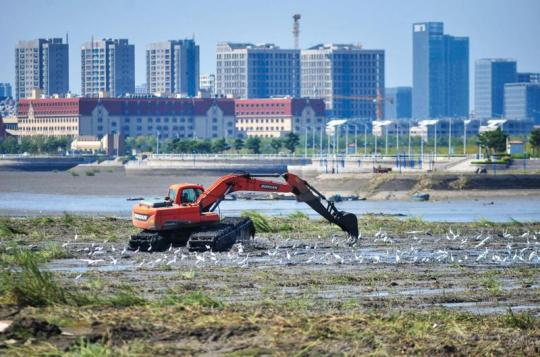
View On WordPress
0 notes